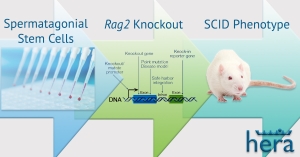Hera Biolabs, the University of Michigan, Case Western Reserve University and other collaborators recently published an article in the American Association for Cancer Research (AACR) journal, Molecular Cancer Therapeutics.

Preclinical oncology research and drug discovery work rely on in vivo studies to examine drug efficacy and safety prior to entering patient trials. Rats have always been the preferred murine model for toxicology study because they offer larger sample size collection, are easier to manipulate surgically, and boast drug-clearance rates similar to those observed in human patients. Despite these advantages, earlier advances in genetic engineering in mice resulted in their preferential use for xenograft studies. However, the limitations of the mouse host often result in non-ideal xenograft models for preclinical research. Hera’s mission is to improve oncology research through the creation of new genetically modified rat models. This publication reflects our first steps demonstrating our ability to manipulate the rat genome to create immunodeficient rat models for use in xenograft studies. To answer this need, researchers at Hera Biolabs have developed an immunodeficient rat model with a functional deletion of the Rag2 gene (SDR knockout rat). In the publication, Hera demonstrates that this knockout rat has a complete lack of mature B cells and a substantially depleted mature T-cell population. This allows for the engraftment of human tumor cell models and patient-derived cell line xenografts. The researchers demonstrated successful engraftment of cancer cells from multiple tissue types, including: (1) a human, KRAS-mutant, non-small cell lung cancer cell line (H358, NCI-H358), (2) a patient-derived, high-grade, serous ovarian cancer cell line (OV81), and (3) a patient-derived, recurrent, endometrial cancer cell line (OV185).
“The SDR rat however is just the first version of these improved oncology models. Hera has since added another mutation in the Il2rg gene” says Dr. Jamling. This new model, the OncoRat® SRG, contains a Rag2 and Il2rg double knockout and has depleted B-, T- and NK-cells. The OncoRat boasts superior xenograft take rates and growth kinetics when compared to mouse models such as NSG mice. The OncoRat enables cell line studies and PDX establishment for difficult samples, unlocking the full utility of xenografts.
References
- American Association for Cancer Research (AACR) journal, Sprague Dawley Rag2-null rats created from engineered spermatogonial stem cells are immunodeficient and permissive to human xenografts. Molecular Cancer Therapeutics. Download